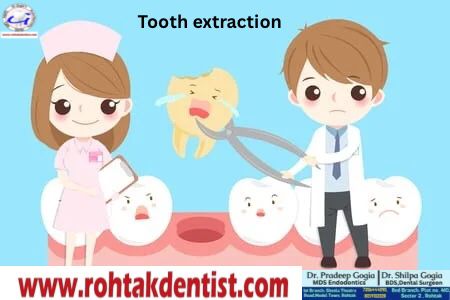
Tooth pain shouldn’t hold you back! At Dr. Gogia’s Super Specialty Dental Care Centre, our experts ensure painless tooth extraction for a healthier, brighter smile . Quick recovery, gentle care, lasting comfort!
When You Need a Tooth Extraction — Causes, Procedure & Aftercare
tooth extraction
Why your dentist may recommend a tooth extraction
There are several common reasons a dentist may advise a tooth extraction:
- Extensive tooth decay: When decay has destroyed too much of the tooth structure to restore with a filling or crown.
- Advanced infection: An infection that cannot be resolved by root canal therapy or where root canal is not feasible.
- Impacted wisdom teeth: Third molars that are blocked from erupting can cause pain, infection, or crowding.
- Orthodontic reasons: Sometimes removing a tooth creates space to align teeth properly.
- Fractured teeth: A tooth with a vertical root fracture or irreparable damage may require extraction.
Types of tooth extraction: simple vs surgical
Understanding the type of tooth extraction helps set expectations:
Simple extraction
A simple extraction is performed on a visible tooth under local anaesthesia. The dentist loosens the tooth with an elevator and removes it with forceps.
Surgical extraction
Surgical extraction is used when the tooth is broken at the gum line or impacted beneath the gum. It may require a small incision and removal of bone—often performed by an oral surgeon.
What happens during the tooth extraction procedure
- Assessment: Clinical exam and X-rays to determine root shape, position, and nearby anatomy.
- Anesthesia: Local anaesthetic numbs the site. Sedation or general anaesthesia may be used in certain cases.
- Removal: For simple extraction, the dentist uses elevators and forceps. For surgical, a small flap and bone removal may be needed.
- Suturing: If a surgical approach is used, the site may be stitched.
- Post-operative instructions: You will be given care steps to reduce bleeding, control pain, and support healing.
Risks, complications, and when to contact your dentist
While most tooth extraction procedures are straightforward, possible complications include:
- Excessive bleeding
- Infection at the extraction site
- Dry socket (alveolar osteitis) — delayed healing with increased pain
- Nerve injury (rare, more common with lower wisdom teeth)
Contact your dentist immediately if you have heavy bleeding that soaks through dressings, fever, severe swelling, or uncontrolled pain.
Aftercare for a quick recovery after tooth extraction
Proper aftercare is the single most important factor in preventing complications after a tooth extraction. Follow these step-by-step tips:
First 24 hours
- Bite gently on gauze for at least 30–45 minutes to form a blood clot.
- Avoid rinsing, spitting, or using a straw for the first 24 hours to reduce risk of dry socket.
- Use pain medication as prescribed and apply ice packs intermittently to control swelling.
48–72 hours
- Begin gentle rinsing with warm saline (½ teaspoon salt in 250 ml warm water) after 24 hours.
- Eat soft foods and avoid hard, crunchy, or spicy foods that irritate the socket.
One week and beyond
- Maintain oral hygiene but be gentle near the extraction area.
- Return for suture removal if stitches were placed and for follow-up checks.
These aftercare steps reduce the chance of dry socket and help you heal faster.
Replacing a missing tooth after extraction
After a healing period, consider tooth replacement to preserve chewing function and prevent shifting of neighbouring teeth. Options include:
- Dental implants: A fixed solution that mimics natural teeth.
- Fixed bridges: Replace a tooth using neighbouring teeth for support.
- Removable partial dentures: A cost-effective temporary or long-term solution.
At Dr. Gogia’s Super Specialty Dental Care Centre, we assess bone health and recommend the best replacement option for your needs.
Frequently asked questions about tooth extraction
Does tooth extraction hurt?
You will be numb during the procedure. Mild to moderate soreness is common after the anaesthetic wears off, and pain is managed with prescribed or over?the?counter medicines.
How long does healing take after a tooth extraction?
Soft tissue healing usually takes 1–2 weeks; complete bone remodeling may take several months. Follow your dentist’s aftercare instructions to speed recovery.
Can I smoke after extraction?
Smoking increases the risk of dry socket. Avoid smoking for at least 72 hours; longer is better.
Helpful links & references
- American Dental Association — Oral Health Topics (external reference)

